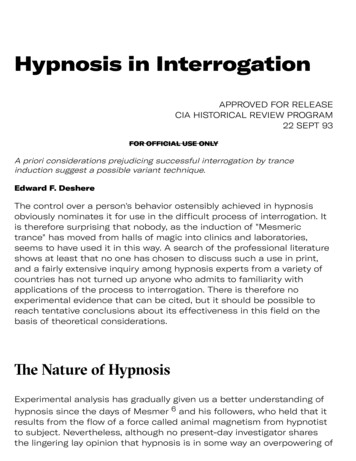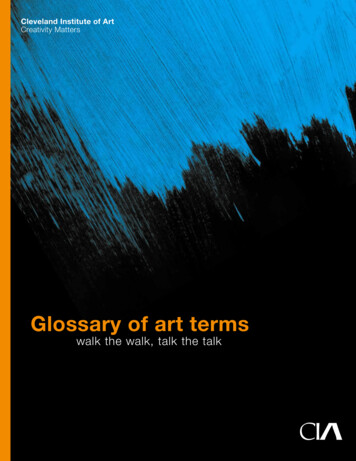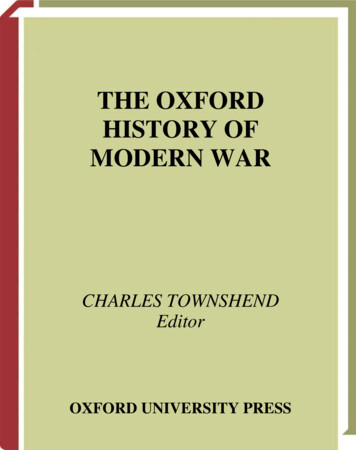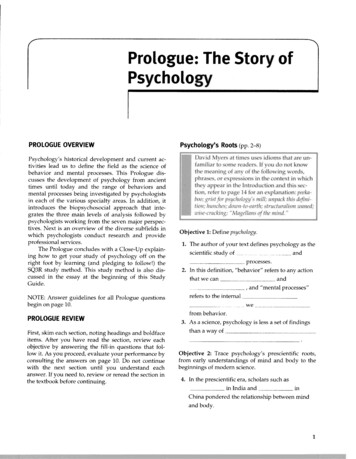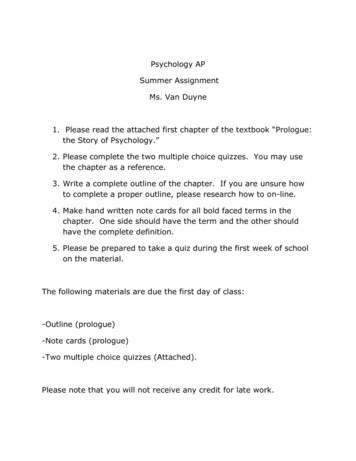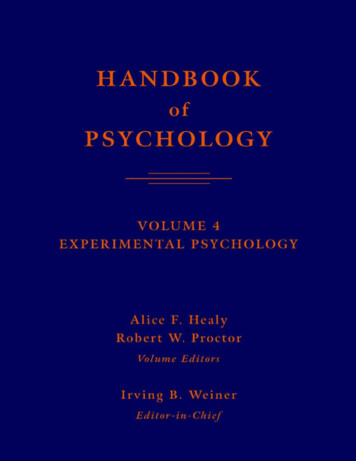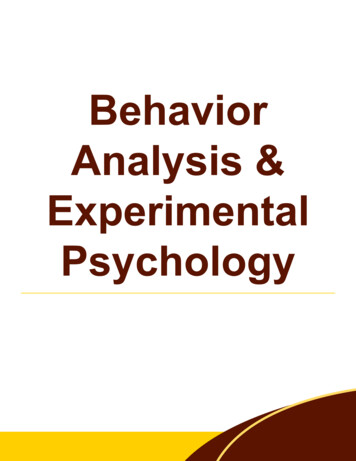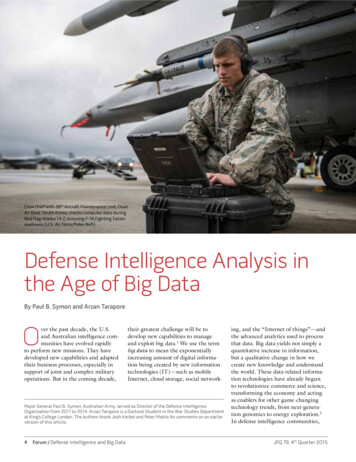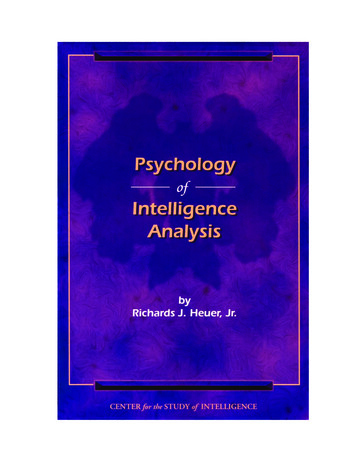
Transcription
ofbyRichards J. Heuer, Jr.CENTER for the STUDY of INTELLIGENCECentral Intelligence Agency1999
Tis book was prepared primarily for the use of US Government ofcials,and the format, coverage, and content were designed to meet their specifc requirements.Because this book is now out of print, this Portable Document File (PDF)is formatted for two-sided printing to facilitate desktop publishing. Itmay be used by US Government agencies to make copies for government purposes and by non-governmental organizations to make copiesfor educational purposes. Because this book may be subject to copyrightrestriction, copies may not be made for any commercial purpose.Tis book will be available at www.odci.gov/csi.All statements of fact, opinion, or analysis expressed in the main textof this book are those of the author. Similarly, all such statements inthe Forward and the Introduction are those of the respective authorsof those sections. Such statements of fact, opinion, or analysis donot necessarily refect the ofcial positions or views of the CentralIntelligence Agency or any other component of the US IntelligenceCommunity. Nothing in the contents of this book should be construed as asserting or implying US Government endorsement of factual statements or interpretations.ISBN 1 929667-00-0Originally published in 1999.iii
Psychology of Intelligence Analysisby Richards J. Heuer, Jr.Author’s Preface .viForeword.ixIntroduction .xiiiPART I—OUR MENTAL MACHINERY.1Chapter 1: Tinking About Tinking .1Chapter 2: Perception: Why Can’t We SeeWhat Is Tere To Be Seen?.7Chapter 3: Memory: How Do We RememberWhat We Know?.17PART II—TOOLS FOR THINKING .31Chapter 4: Strategies for Analytical Judgment:Transcending the Limits of Incomplete Information .31Chapter 5: Do You Really Need More Information? .51Chapter 6: Keeping an Open Mind .65Chapter 7: Structuring Analytical Problems .85Chapter 8: Analysis of Competing Hypotheses .95PART III—COGNITIVE BIASES.111Chapter 9: What Are Cognitive Biases?.111Chapter 10: Biases in Evaluation of Evidence.115v
Chapter 11: Biases in Perception of Cause and Efect127Chapter 12: Biases in Estimating Probabilities .147Chapter 13: Hindsight Biases in Evaluation ofIntelligence Reporting.161PART IV—CONCLUSIONS .173Chapter 14: Improving Intelligence Analysis.173vi
Author’s PrefaceTis volume pulls together and republishes, with some editing,updating, and additions, articles written during 1978–86 for internaluse within the CIA Directorate of Intelligence. Four of the articles alsoappeared in the Intelligence Community journal Studies in Intelligenceduring that time frame. Te information is relatively timeless and stillrelevant to the never-ending quest for better analysis.Te articles are based on reviewing cognitive psychology literatureconcerning how people process information to make judgments on incomplete and ambiguous information. I selected the experiments andfndings that seem most relevant to intelligence analysis and most in needof communication to intelligence analysts. I then translated the technical reports into language that intelligence analysts can understand andinterpreted the relevance of these fndings to the problems intelligenceanalysts face.Te result is a compromise that may not be wholly satisfactory toeither research psychologists or intelligence analysts. Cognitive psychologists and decision analysts may complain of oversimplifcation, whilethe non-psychologist reader may have to absorb some new terminology.Unfortunately, mental processes are so complex that discussion of themdoes require some specialized vocabulary. Intelligence analysts who haveread and thought seriously about the nature of their craft should haveno difculty with this book. Tose who are plowing virgin ground mayrequire serious efort.I wish to thank all those who contributed comments and suggestionson the draft of this book: Jack Davis (who also wrote the Introduction);four former Directorate of Intelligence (DI) analysts whose names cannotbe cited here; my current colleague, Prof. Teodore Sarbin; and my editor at the CIA’s Center for the Study of Intelligence, Hank Appelbaum.All made many substantive and editorial suggestions that helped greatlyto make this a better book.—Richards J. Heuer, Jr.vii
ForewordBy Douglas MacEachin1My frst exposure to Dick Heuer’s work was about 18 years ago, andI have never forgotten the strong impression it made on me then. Tatwas at about the midpoint in my own career as an intelligence analyst.After another decade and a half of experience, and the opportunity during the last few years to study many historical cases with the beneft ofarchival materials from the former USSR and Warsaw Pact regimes, reading Heuer’s latest presentation has had even more resonance.I know from frst-hand encounters that many CIA ofcers tend toreact skeptically to treatises on analytic epistemology. Tis is understandable. Too often, such treatises end up prescribing models as answers to theproblem. Tese models seem to have little practical value to intelligenceanalysis, which takes place not in a seminar but rather in a fast-breakingworld of policy. But that is not the main problem Heuer is addressing.What Heuer examines so clearly and efectively is how the humanthought process builds its own models through which we process information. Tis is not a phenomenon unique to intelligence; as Heuer’sresearch demonstrates, it is part of the natural functioning of the humancognitive process, and it has been demonstrated across a broad range offelds ranging from medicine to stock market analysis.Te process of analysis itself reinforces this natural function of thehuman brain. Analysis usually involves creating models, even thoughthey may not be labeled as such. We set forth certain understandings andexpectations about cause-and-efect relationships and then process andinterpret information through these models or flters.Te discussion in Chapter 5 on the limits to the value of additionalinformation deserves special attention, in my view—particularly for an1. Douglas MacEachin is a former CIA Deputy Director of Intelligence. After 32 years with theAgency, he retired in 1997 and became a Senior Fellow at Harvard University’s John F. KennedySchool of Government.ix
intelligence organization. What it illustrates is that too often, newly acquired information is evaluated and processed through the existing analytic model, rather than being used to reassess the premises of the modelitself. Te detrimental efects of this natural human tendency stem fromthe raison d’etre of an organization created to acquire special, critical information available only through covert means, and to produce analysisintegrating this special information with the total knowledge base.I doubt that any veteran intelligence ofcer will be able to read thisbook without recalling cases in which the mental processes described byHeuer have had an adverse impact on the quality of analysis. How manytimes have we encountered situations in which completely plausiblepremises, based on solid expertise, have been used to construct a logicallyvalid forecast—with virtually unanimous agreement—that turned outto be dead wrong? In how many of these instances have we determined,with hindsight, that the problem was not in the logic but in the factthat one of the premises—however plausible it seemed at the time—wasincorrect? In how many of these instances have we been forced to admitthat the erroneous premise was not empirically based but rather a conclusion developed from its own model (sometimes called an assumption)?And in how many cases was it determined after the fact that informationhad been available which should have provided a basis for questioningone or more premises, and that a change of the relevant premise(s) wouldhave changed the analytic model and pointed to a diferent outcome?Te commonly prescribed remedy for shortcomings in intelligenceanalysis and estimates—most vociferously after intelligence “failures”—isa major increase in expertise. Heuer’s research and the studies he citespose a serious challenge to that conventional wisdom. Te data show thatexpertise itself is no protection from the common analytic pitfalls thatare endemic to the human thought process. Tis point has been demonstrated in many felds beside intelligence analysis.A review of notorious intelligence failures demonstrates that the analytic traps caught the experts as much as anybody. Indeed, the data showthat when experts fall victim to these traps, the efects can be aggravatedby the confdence that attaches to expertise—both in their own view andin the perception of others.Tese observations should in no way be construed as a denigrationof the value of expertise. On the contrary, my own 30-plus years in thebusiness of intelligence analysis biased me in favor of the view that, endx
less warnings of information overload notwithstanding, there is no suchthing as too much information or expertise. And my own observationsof CIA analysts sitting at the same table with publicly renowned expertshave given me great confdence that attacks on the expertise issue aregrossly misplaced. Te main diference is that one group gets to promoteits reputations in journals, while the other works in a closed environmentin which the main readers are members of the intelligence world’s mostchallenging audience—the policymaking community.Te message that comes through in Heuer’s presentation is that information and expertise are a necessary but not sufcient means of making intelligence analysis the special product that it needs to be. A comparable efort has to be devoted to the science of analysis. Tis efort has tostart with a clear understanding of the inherent strengths and weaknessesof the primary analytic mechanism—the human mind—and the way itprocesses information.I believe there is a signifcant cultural element in how intelligenceanalysts defne themselves: Are we substantive experts employed by CIA,or are we professional analysts and intelligence ofcers whose expertiselies in our ability to adapt quickly to diverse issues and problems andanalyze them efectively? In the world at large, substantive expertise is farmore abundant than expertise on analytic science and the human mentalprocessing of information. Dick Heuer makes clear that the pitfalls the human mental process sets for analysts cannot be eliminated; they are part ofus. What can be done is to train people how to look for and recognize thesemental obstacles, and how to develop procedures designed to ofset them.Given the centrality of analytic science for the intelligence mission,a key question that Heuer’s book poses is: Compared with other areas ofour business, have we committed a commensurate efort to the study ofanalytic science as a professional requirement? How do the efort and resource commitments in this area compare to, for example, the efort andcommitment to the development of analysts’ writing skills?Heuer’s book does not pretend to be the last word on this issue.Hopefully, it will be a stimulant for much more work.xi
IntroductionImproving Intelligence Analysisat CIA: Dick Heuer’s Contributionto Intelligence Analysisby Jack Davis I applaud CIA’s Center for the Study of Intelligence for making thework of Richards J. Heuer, Jr. on the psychology of intelligence analysisavailable to a new generation of intelligence practitioners and scholars.Dick Heuer’s ideas on how to improve analysis focus on helpinganalysts compensate for the human mind’s limitations in dealing withcomplex problems that typically involve ambiguous information, multiple players, and fuid circumstances. Such multi-faceted estimative challenges have proliferated in the turbulent post-Cold War world.Heuer’s message to analysts can be encapsulated by quoting twosentences from Chapter 4 of this book:Intelligence analysts should be self-conscious about their reasoning processes. Tey should think about how they makejudgments and reach conclusions, not just about the judgmentsand conclusions themselves.Heuer’s ideas are applicable to any analytical endeavor. In thisIntroduction, I have concentrated on his impact—and that of other pioneer thinkers in the intelligence analysis feld—at CIA, because that isthe institution that Heuer and his predecessors, and I myself, know best,having spent the bulk of our intelligence careers there.2. Jack Davis served with the Directorate of Intelligence (DI), the National IntelligenceCouncil, and the Ofce of Training during his CIA career. He is now an independent contractor who specializes in developing and teaching analytic tradecraft. Among his publications isUncertainty, Surprise, and Warning (1996).xiii
Leading Contributors to Quality of AnalysisIntelligence analysts, in seeking to make sound judgments, are always under challenge from the complexities of the issues they addressand from the demands made on them for timeliness and volume of production. Four Agency individuals over the decades stand out for havingmade major contributions on how to deal with these challenges to thequality of analysis.My short list of the people who have had the greatest positive impact on CIA analysis consists of Sherman Kent, Robert Gates, DouglasMacEachin, and Richards Heuer. My selection methodology was simple.I asked myself: Whose insights have infuenced me the most during myfour decades of practicing, teaching, and writing about analysis
Because this book is now out of print, this Portable Document File (PDF) is formatted for two-sided printing to facilitate desktop publishing. It may be used by US Government agencies to make copies for govern-ment purposes and by non-governmental organizations to make copies for educational purposes. Because this book may be subject to copyright restriction, copies may not be made for any .
